View in other NatureServe Network Field Guides
NatureServe
Montana
Utah
Wyoming
Idaho
Wisconsin
British Columbia
South Carolina
Yukon
California
New York
Meadow Vole - Microtus pennsylvanicus
Native Species
Global Rank:
G5
State Rank:
S5
(see State Rank Reason below)
Agency Status
USFWS:
USFS:
BLM:
External Links
State Rank Reason (see State Rank above)
Common and widespread. Readily uses human-modified habitats
General Description
The Meadow Vole, under 6 inches in length from tip of nose to end of tail and a little over an ounce in weight, has the rotund body, blunt nose, and bright black eyes of all voles. On top it can be yellowish or reddish brown to dark brown, with black-tipped hairs. Below it is buffy to lead gray, with silver-tipped hairs. In Montana, Meadow Voles and Montane Voles look much alike; however, the Meadow Voles tend to be darker brown and have plantar tubercles (foot pads) (Foresman 2012).
Currently there is some taxonomic uncertainty associated with this species. Jackson and Cook (2020) suggest that there is sufficient genetic difference between populations to split the species into four distinct clades across North America. Based on a single record from central Montana, they suggest that individuals from Montana fall within the central clade and should be considered the Western Meadow Vole (M. drummondii). However, due to the scarcity of samples and proximity of their range delineation, it is possible that animals in northwestern Montana could be from the northwestern clade and also considered M. drummondii. Further research into these differences and species concepts is necessary to confirm these proposed changes to the taxonomy of this group.
Species Range
Montana Range
Range Descriptions
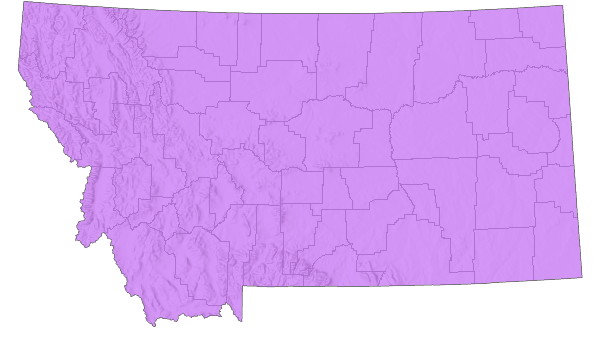
 Native
Native
Global Range

Estimated global breeding range area is: 11,312,395 km
2 (Approximately <1% in Montana)
See information about
 iNaturalist Geomodels
iNaturalist Geomodels
Observations in Montana Natural Heritage Program Database
Number of Observations: 1610
(Click on the following maps and charts to see full sized version)
Map Help and Descriptions
Relative Density
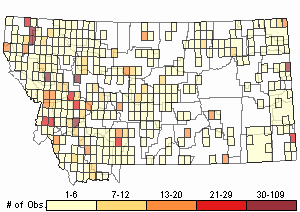
Recency
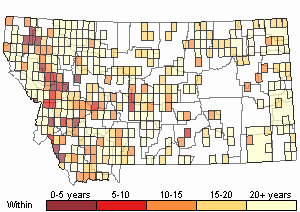

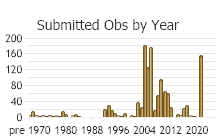
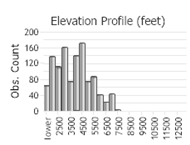 (Observations spanning multiple months or years are excluded from time charts)
(Observations spanning multiple months or years are excluded from time charts)
Migration
Non-migratory.
Habitat
Wet grassland habitat but not above timberline in grassy alpine tundra. Where M. montanus not present, M. pennsylvanicus may inhabit drier grasslands (Hoffmann and Pattie 1968).
Ecological Systems Associated with this Species
- Details on Creation and Suggested Uses and Limitations
How Associations Were Made
We associated the use and habitat quality (common or occasional) of each of the 82 ecological systems mapped in Montana for
vertebrate animal species that regularly breed, overwinter, or migrate through the state by:
- Using personal observations and reviewing literature that summarize the breeding, overwintering, or migratory habitat requirements of each species (Dobkin 1992, Hart et al. 1998, Hutto and Young 1999, Maxell 2000, Foresman 2012, Adams 2003, and Werner et al. 2004);
- Evaluating structural characteristics and distribution of each ecological system relative to the species' range and habitat requirements;
- Examining the observation records for each species in the state-wide point observation database associated with each ecological system;
- Calculating the percentage of observations associated with each ecological system relative to the percent of Montana covered by each ecological system to get a measure of "observations versus availability of habitat".
Species that breed in Montana were only evaluated for breeding habitat use, species that only overwinter in Montana were only evaluated for overwintering habitat use, and species that only migrate through Montana were only evaluated for migratory habitat use.
In general, species were listed as associated with an ecological system if structural characteristics of used habitat documented in the literature were present in the ecological system or large numbers of point observations were associated with the ecological system.
However, species were not listed as associated with an ecological system if there was no support in the literature for use of structural characteristics in an ecological system,
even if point observations were associated with that system.
Common versus occasional association with an ecological system was assigned based on the degree to which the structural characteristics of an ecological system matched the preferred structural habitat characteristics for each species as represented in scientific literature.
The percentage of observations associated with each ecological system relative to the percent of Montana covered by each ecological system was also used to guide assignment of common versus occasional association.
If you have any questions or comments on species associations with ecological systems, please contact the Montana Natural Heritage Program's Senior Zoologist.
Suggested Uses and Limitations
Species associations with ecological systems should be used to generate potential lists of species that may occupy broader landscapes for the purposes of landscape-level planning.
These potential lists of species should not be used in place of documented occurrences of species (this information can be requested at:
mtnhp.mt.gov/requests) or systematic surveys for species and evaluations of habitat at a local site level by trained biologists.
Users of this information should be aware that the land cover data used to generate species associations is based on imagery from the late 1990s and early 2000s and was only intended to be used at broader landscape scales.
Land cover mapping accuracy is particularly problematic when the systems occur as small patches or where the land cover types have been altered over the past decade.
Thus, particular caution should be used when using the associations in assessments of smaller areas (e.g., evaluations of public land survey sections).
Finally, although a species may be associated with a particular ecological system within its known geographic range, portions of that ecological system may occur outside of the species' known geographic range.
Literature Cited
- Adams, R.A. 2003. Bats of the Rocky Mountain West; natural history, ecology, and conservation. Boulder, CO: University Press of Colorado. 289 p.
- Dobkin, D. S. 1992. Neotropical migrant land birds in the Northern Rockies and Great Plains. USDA Forest Service, Northern Region. Publication No. R1-93-34. Missoula, MT.
- Foresman, K.R. 2012. Mammals of Montana. Second edition. Mountain Press Publishing, Missoula, Montana. 429 pp.
- Hart, M.M., W.A. Williams, P.C. Thornton, K.P. McLaughlin, C.M. Tobalske, B.A. Maxell, D.P. Hendricks, C.R. Peterson, and R.L. Redmond. 1998. Montana atlas of terrestrial vertebrates. Montana Cooperative Wildlife Research Unit, University of Montana, Missoula, MT. 1302 p.
- Hutto, R.L. and J.S. Young. 1999. Habitat relationships of landbirds in the Northern Region, USDA Forest Service, Rocky Mountain Research Station RMRS-GTR-32. 72 p.
- Maxell, B.A. 2000. Management of Montana's amphibians: a review of factors that may present a risk to population viability and accounts on the identification, distribution, taxonomy, habitat use, natural history, and the status and conservation of individual species. Report to U.S. Forest Service Region 1. Missoula, MT: Wildlife Biology Program, University of Montana. 161 p.
- Werner, J.K., B.A. Maxell, P. Hendricks, and D. Flath. 2004. Amphibians and reptiles of Montana. Missoula, MT: Mountain Press Publishing Company. 262 p.
- Commonly Associated with these Ecological Systems
Forest and Woodland Systems
Grassland Systems
Human Land Use
Recently Disturbed or Modified
Shrubland, Steppe and Savanna Systems
Wetland and Riparian Systems
- Occasionally Associated with these Ecological Systems
Human Land Use
Recently Disturbed or Modified
Shrubland, Steppe and Savanna Systems
Food Habits
Grasses, sedges & herbaceous plants. May use fungi, particularly endogone. Will use insects. Occasionally will use carrion (Reich 1981).
Ecology
Makes extensive runways. In eastern MT mean home range was 0.13 acres for females, 0.14 acres for lactating females, 0.23 acres for males (McCann 1976). Low longevity, high juvenile mortality (Jones et al. 1983).
Reproductive Characteristics
Productivity varies with climate and population trends. Promiscuous. Probably 5 to 6 young/litter. Young disperse from natal nest when 3 to 4 weeks old (Jones et al. 1983).
Stewardship Responsibility
References
- Literature Cited AboveLegend:
 View Online Publication
View Online Publication Foresman, K.R. 2012. Mammals of Montana. Second edition. Mountain Press Publishing, Missoula, Montana. 429 pp.
Foresman, K.R. 2012. Mammals of Montana. Second edition. Mountain Press Publishing, Missoula, Montana. 429 pp. Hoffmann, R.S. and D.L. Pattie. 1968. A guide to Montana mammals: identification, habitat, distribution, and abundance. Missoula, MT: University of Montana. 133 p.
Hoffmann, R.S. and D.L. Pattie. 1968. A guide to Montana mammals: identification, habitat, distribution, and abundance. Missoula, MT: University of Montana. 133 p. Jones, J.K., D.M. Armstrong, R.S. Hoffmann and C. Jones. 1983. Mammals of the northern Great Plains. University of Nebraska Press, Lincoln. 379 pp.
Jones, J.K., D.M. Armstrong, R.S. Hoffmann and C. Jones. 1983. Mammals of the northern Great Plains. University of Nebraska Press, Lincoln. 379 pp. McCann, S.A. 1976. Home ranges of the meadow vole and deer mouse (on a reclamation test pit in eastern Montana). Proceedings of the Montana Academy of Sciences 36:11-17.
McCann, S.A. 1976. Home ranges of the meadow vole and deer mouse (on a reclamation test pit in eastern Montana). Proceedings of the Montana Academy of Sciences 36:11-17. Reich, L.M. 1981. Microtus pennsylvanicus. Mamm. Species No. 159. 8 pp.
Reich, L.M. 1981. Microtus pennsylvanicus. Mamm. Species No. 159. 8 pp.
- Additional ReferencesLegend:
 View Online Publication
View Online Publication
Do you know of a citation we're missing? [WWPC] Washington Water Power Company. 1995. 1994 wildlife report Noxon Rapids and Cabinet Gorge Reservoirs. Washington Water Power Company. Spokane, WA.
[WWPC] Washington Water Power Company. 1995. 1994 wildlife report Noxon Rapids and Cabinet Gorge Reservoirs. Washington Water Power Company. Spokane, WA. Adelman, E.B. 1979. A survey of the nongame mammals in the Upper Rattlesnake Creek drainage of western Montana. M.S. thesis. University of Montana, Missoula. 129 pp.
Adelman, E.B. 1979. A survey of the nongame mammals in the Upper Rattlesnake Creek drainage of western Montana. M.S. thesis. University of Montana, Missoula. 129 pp. Ambrose, H. W. 1973. An experimental study of some factors affecting the spatial and temporal activity of Microtus pennsylvanicus. J. Mammal. 54:79-110.
Ambrose, H. W. 1973. An experimental study of some factors affecting the spatial and temporal activity of Microtus pennsylvanicus. J. Mammal. 54:79-110. Ambrose, H.W. 1973. An experimental study of some factors affecting the spatial and temporal activity of Microtus pennsylvanicus. Journal of Mammalogy 54:79-110.
Ambrose, H.W. 1973. An experimental study of some factors affecting the spatial and temporal activity of Microtus pennsylvanicus. Journal of Mammalogy 54:79-110. Bauer, Delane, 2002, 2002 Four Seasons Wildlife Study. Savage Mine Report, Richland County, Montana.
Bauer, Delane, 2002, 2002 Four Seasons Wildlife Study. Savage Mine Report, Richland County, Montana. Bowdoin NWR. 2000. A survey of the small, terrestrial mammals at Bowdoin NWR: Malta, Montana.
Bowdoin NWR. 2000. A survey of the small, terrestrial mammals at Bowdoin NWR: Malta, Montana. Bramblett, R.G., and A.V. Zale. 2002. Montana Prairie Riparian Native Species Report. Montana Cooperative Fishery Research Unit, Montana State University - Bozeman.
Bramblett, R.G., and A.V. Zale. 2002. Montana Prairie Riparian Native Species Report. Montana Cooperative Fishery Research Unit, Montana State University - Bozeman. Buck, C.L. 1939. Pattern correlation of mammalian teeth as a means of identification. M.Sc. Thesis. Bozeman, Montana: Montana State University. 55 p.
Buck, C.L. 1939. Pattern correlation of mammalian teeth as a means of identification. M.Sc. Thesis. Bozeman, Montana: Montana State University. 55 p. Burnett, G.W. 1981. Movements and habitat use of American Marten in Glacier National Park, Montana. M.S. Thesis. University of Montana. Missoula. 130 pp.
Burnett, G.W. 1981. Movements and habitat use of American Marten in Glacier National Park, Montana. M.S. Thesis. University of Montana. Missoula. 130 pp. Butts, T.W., Western Technology and R.L. Eng. 1993. Continental Lime Indian Creek Mine, Townsend, MT. Life of Mine Wildlife Reconnaissance. In Life-of-Mine Amendment. Continental Lime, Inc., Indian Creek Mine & Plant. Vol. 2. October 13, 1992.
Butts, T.W., Western Technology and R.L. Eng. 1993. Continental Lime Indian Creek Mine, Townsend, MT. Life of Mine Wildlife Reconnaissance. In Life-of-Mine Amendment. Continental Lime, Inc., Indian Creek Mine & Plant. Vol. 2. October 13, 1992. Carlsen, T. 1980. Small mammal trapping in the Elkhorns. [Unpublished report]. 7 pp.
Carlsen, T. 1980. Small mammal trapping in the Elkhorns. [Unpublished report]. 7 pp. Carlsen, T. and R. Northrup. 1992. Canyon Ferry Wildlife Management Area Final Draft Management Plan. March 1992.
Carlsen, T. and R. Northrup. 1992. Canyon Ferry Wildlife Management Area Final Draft Management Plan. March 1992. Clark, S.G. and M.R. Stromberg. 1987. Mammals in Wyoming. University of Kansas Museum of Natural History, Public Education Series Number 10. xii + 314 pp.
Clark, S.G. and M.R. Stromberg. 1987. Mammals in Wyoming. University of Kansas Museum of Natural History, Public Education Series Number 10. xii + 314 pp. Cobell, B. and R. Wagner. 2002. An evaluation of the terrestrial and aquatic resources of Malmstrom Air Force Base. USFWS - Montana Fish and Wildlife Management Assistance Office. 28 pgs + append.
Cobell, B. and R. Wagner. 2002. An evaluation of the terrestrial and aquatic resources of Malmstrom Air Force Base. USFWS - Montana Fish and Wildlife Management Assistance Office. 28 pgs + append. Confluence Consulting Inc. 2010. Montana Department of Transportation Wetland Mitigation Monitoring Reports (various sites). MDT Helena, MT.
Confluence Consulting Inc. 2010. Montana Department of Transportation Wetland Mitigation Monitoring Reports (various sites). MDT Helena, MT. Confluence Consulting Inc. 2011. Montana Department of Transportation Wetland Mitigation Monitoring Reports (various sites). MDT Helena, MT.
Confluence Consulting Inc. 2011. Montana Department of Transportation Wetland Mitigation Monitoring Reports (various sites). MDT Helena, MT. Confluence Consulting Inc. 2012. Montana Department of Transportation Wetland Mitigation Monitoring Reports (various sites). MDT Helena, MT.
Confluence Consulting Inc. 2012. Montana Department of Transportation Wetland Mitigation Monitoring Reports (various sites). MDT Helena, MT. Connolly-Newman, Hayley R. 2013. Effect of cover on small mammal abundance and movement through wildlife underpasses. M.S. Thesis. University of Montana. Missoula, MT.
Connolly-Newman, Hayley R. 2013. Effect of cover on small mammal abundance and movement through wildlife underpasses. M.S. Thesis. University of Montana. Missoula, MT. Craighead, A.C. 2000. Pellet and scat analysis as indicators of present and past habitats. M.Sc. Theses. Bozeman, MT: Montana State University. 219 p.
Craighead, A.C. 2000. Pellet and scat analysis as indicators of present and past habitats. M.Sc. Theses. Bozeman, MT: Montana State University. 219 p. Dice, L.R. 1923. Mammal associations and habitats of the Flathead Lake Region, Montana. Ecology 4(3): 247-260.
Dice, L.R. 1923. Mammal associations and habitats of the Flathead Lake Region, Montana. Ecology 4(3): 247-260. Douglass, R.J. 1973. Spatial interactions and microhabitat selections of two locally sympatric voles, Microtus montanus and Microtus pennsylvanicus. Ph.D. Dissertation. Bozeman, Montana: Montana State University. 48 p.
Douglass, R.J. 1973. Spatial interactions and microhabitat selections of two locally sympatric voles, Microtus montanus and Microtus pennsylvanicus. Ph.D. Dissertation. Bozeman, Montana: Montana State University. 48 p. Douglass, R.J. 1976. Spatial interactions and microhabitat selections of two locally sympatric voles, Microtus montanus and Microtus pennsylvanicus. Ecology 57: 346-352.
Douglass, R.J. 1976. Spatial interactions and microhabitat selections of two locally sympatric voles, Microtus montanus and Microtus pennsylvanicus. Ecology 57: 346-352. ECON, Inc. (Ecological Consulting Service), Helena, MT., 1975, Colstrip 10 x 20 Area wildlife and wildlife habitat annual monitoring report, 1975. Proj. 71-23-A. December 31, 1975.
ECON, Inc. (Ecological Consulting Service), Helena, MT., 1975, Colstrip 10 x 20 Area wildlife and wildlife habitat annual monitoring report, 1975. Proj. 71-23-A. December 31, 1975. Eng, R.L. 1976. Wildlife Baseline Study [for West Fork of the Stillwater and Picket Pin drainages]
Eng, R.L. 1976. Wildlife Baseline Study [for West Fork of the Stillwater and Picket Pin drainages] Feigley, H.P. 1981. Studies on native small mammals as intermediate hosts of Echinococcus multilocularis. M.Sc. Thesis. Bozeman, Montana: Montana State University. 50 p.
Feigley, H.P. 1981. Studies on native small mammals as intermediate hosts of Echinococcus multilocularis. M.Sc. Thesis. Bozeman, Montana: Montana State University. 50 p. Findley, J. S. 1951. Habitat preferences of four species of Microtus in Jackson Hole, Wyoming. J. Mammal. 32(1):118-120.
Findley, J. S. 1951. Habitat preferences of four species of Microtus in Jackson Hole, Wyoming. J. Mammal. 32(1):118-120. Fjell, Alan K., and Brian R. Mahan, compilers., 1984, Peabody Coal Company Big Sky Mine, Rosebud County, MT. Wildlife monitoring report: 1983 field season. February 1984.
Fjell, Alan K., and Brian R. Mahan, compilers., 1984, Peabody Coal Company Big Sky Mine, Rosebud County, MT. Wildlife monitoring report: 1983 field season. February 1984. Foresman, K.R. 2001. The wild mammals of Montana. American Society of Mammalogists, Special Publication Number 12. Lawrence, KS. 278 pp.
Foresman, K.R. 2001. The wild mammals of Montana. American Society of Mammalogists, Special Publication Number 12. Lawrence, KS. 278 pp. Genter, D.L. 1986. Habitat selection and behavioral interactions of two sympatric voles, Microtus montanus and Microtus pennsylvanicus. M.A. thesis. University of Montana, Missoula. 49 pp.
Genter, D.L. 1986. Habitat selection and behavioral interactions of two sympatric voles, Microtus montanus and Microtus pennsylvanicus. M.A. thesis. University of Montana, Missoula. 49 pp. Haight, C.P. 1937. Some observations on the predator-prey complex in the Gallatin Valley. M.Sc. Thesis. Bozeman, Montana: Montana State University. 58 p.
Haight, C.P. 1937. Some observations on the predator-prey complex in the Gallatin Valley. M.Sc. Thesis. Bozeman, Montana: Montana State University. 58 p. Hanauska-Brown, L., B.A. Maxell, A. Petersen, and S. Story. 2014. Diversity Monitoring in Montana 2008-2010 Final Report. Montana Fish, Wildlife & Parks. Helena, MT. 78 pp.
Hanauska-Brown, L., B.A. Maxell, A. Petersen, and S. Story. 2014. Diversity Monitoring in Montana 2008-2010 Final Report. Montana Fish, Wildlife & Parks. Helena, MT. 78 pp. Hawley, V.D. 1955. The ecology of the marten in Glacier National Park. M.S. thesis. University of Montana, Missoula. 131 pp.
Hawley, V.D. 1955. The ecology of the marten in Glacier National Park. M.S. thesis. University of Montana, Missoula. 131 pp. Hendricks, P. and M. Roedel. 2001. A faunal survey of the Centennial Valley Sandhills, Beaverhead County, Montana. Report to the U.S. Bureau of Land Management and U.S. Fish and Wildlife Service. Montana Natural Heritage Program, Helena, MT. 44 p.
Hendricks, P. and M. Roedel. 2001. A faunal survey of the Centennial Valley Sandhills, Beaverhead County, Montana. Report to the U.S. Bureau of Land Management and U.S. Fish and Wildlife Service. Montana Natural Heritage Program, Helena, MT. 44 p. Hendricks, P., S. Lenard, D.M. Stagliano, and B.A. Maxell. 2013. Baseline nongame wildlife surveys on the Fort Peck Indian Reservation. Report to the Assiniboine and Sioux Tribes of the Fort Peck Indian Reservation. Montana Natural Heritage Program, Helena, MT. 83 p.
Hendricks, P., S. Lenard, D.M. Stagliano, and B.A. Maxell. 2013. Baseline nongame wildlife surveys on the Fort Peck Indian Reservation. Report to the Assiniboine and Sioux Tribes of the Fort Peck Indian Reservation. Montana Natural Heritage Program, Helena, MT. 83 p. Hodgeson, J.R. 1972. Local distribution of Microtus montanus and Microtus pennsylvanicus in southwestern Montana. J. Mammal. 53(3): 487-499.
Hodgeson, J.R. 1972. Local distribution of Microtus montanus and Microtus pennsylvanicus in southwestern Montana. J. Mammal. 53(3): 487-499. Hodgson, J. R. 1972. Local distribulion of Microtus montanus and M. pennsylvanicus in southwestern Montana. J. Mammal. 53:487-499.
Hodgson, J. R. 1972. Local distribulion of Microtus montanus and M. pennsylvanicus in southwestern Montana. J. Mammal. 53:487-499. Hodgson, J.R. 1970. Ecological distribution of Microtus montanus and Microtus pennsylvanicus in an area of geographic sympatry in southwestern Montana. Ph.D. Dissertation. Bozeman, Montana: Montana State University. 65 p.
Hodgson, J.R. 1970. Ecological distribution of Microtus montanus and Microtus pennsylvanicus in an area of geographic sympatry in southwestern Montana. Ph.D. Dissertation. Bozeman, Montana: Montana State University. 65 p. Johnson, L.J. 1960. Mammal studies on the Lubrecht Forest, Montana: a preliminary report. Proc. Mont. Acad. Sci. 20: 40-47.
Johnson, L.J. 1960. Mammal studies on the Lubrecht Forest, Montana: a preliminary report. Proc. Mont. Acad. Sci. 20: 40-47. Joslin, Gayle, and Heidi B. Youmans. 1999. Effects of recreation on Rocky Mountain wildlife: a review for Montana. [Montana]: Montana Chapter of the Wildlife Society.
Joslin, Gayle, and Heidi B. Youmans. 1999. Effects of recreation on Rocky Mountain wildlife: a review for Montana. [Montana]: Montana Chapter of the Wildlife Society. Key, C.H. 1979. Mammalian utilization of floodplain habitats along the North Fork of the Flathead River in Glacier National Park, Montana. M.S. thesis. University of Montana, Missoula.
Key, C.H. 1979. Mammalian utilization of floodplain habitats along the North Fork of the Flathead River in Glacier National Park, Montana. M.S. thesis. University of Montana, Missoula. Kinsella, J. M. 1966. Helminths of Microtinae in western Montana. M.A. thesis. University of Montana, Missoula. 61 pp.
Kinsella, J. M. 1966. Helminths of Microtinae in western Montana. M.A. thesis. University of Montana, Missoula. 61 pp. Koplin, J.R. 1962. Competition and niche segregation in the genus Microtus. M.S. thesis. Montana State University. 66 pp.
Koplin, J.R. 1962. Competition and niche segregation in the genus Microtus. M.S. thesis. Montana State University. 66 pp. Krebs, C.J., B.L. Keller and R.H. Tamarin. 1969. Microtus population biology: demographic changes in fluctuating populations of M. ochrogaster and M. pennsylvanicus in southern Indiana. Ecology 50(4):587-607.
Krebs, C.J., B.L. Keller and R.H. Tamarin. 1969. Microtus population biology: demographic changes in fluctuating populations of M. ochrogaster and M. pennsylvanicus in southern Indiana. Ecology 50(4):587-607. Kritzman, E.B. 1977. Little mammals of the Pacific Northwest. Pacific Search Press, Seattle, WA.
Kritzman, E.B. 1977. Little mammals of the Pacific Northwest. Pacific Search Press, Seattle, WA. Lampe, R.P., J.K. Jones Jr., R.S. Hoffmann, and E.C. Birney. 1974. The mammals of Carter County, southeastern Montana. Occa. Pap. Mus. Nat. Hist. Univ. Kan. 25:1-39.
Lampe, R.P., J.K. Jones Jr., R.S. Hoffmann, and E.C. Birney. 1974. The mammals of Carter County, southeastern Montana. Occa. Pap. Mus. Nat. Hist. Univ. Kan. 25:1-39. Land & Water Consulting, Inc. 2002. Montana Dept. of Transportation Wetland Mitigation Monitoring Report. Year 2001: Creston Site, Creston, Montana. Project No. 130091.007. July 2002. In 2001 Wetland Mitigation Monitoring Reports, Vol. I.
Land & Water Consulting, Inc. 2002. Montana Dept. of Transportation Wetland Mitigation Monitoring Report. Year 2001: Creston Site, Creston, Montana. Project No. 130091.007. July 2002. In 2001 Wetland Mitigation Monitoring Reports, Vol. I. Land & Water Consulting, Inc., Missoula, MT., 2002, Montana Dept. of Transportation Wetland Mitigation Monitoring Report, Year 2001: Big Spring Creek, Lewistown, Montana. Proj. No. 130091.029. July 2002. In 2001 Wetland Mitigation Monitoring Reports, Vol. I.
Land & Water Consulting, Inc., Missoula, MT., 2002, Montana Dept. of Transportation Wetland Mitigation Monitoring Report, Year 2001: Big Spring Creek, Lewistown, Montana. Proj. No. 130091.029. July 2002. In 2001 Wetland Mitigation Monitoring Reports, Vol. I. Linzey, A.V. 1984. Patterns of coexistence in Synaptomys cooperi and Microtus pennsylvanicus. Ecology. 65:382-393.
Linzey, A.V. 1984. Patterns of coexistence in Synaptomys cooperi and Microtus pennsylvanicus. Ecology. 65:382-393. MacCracken, J.G., D.W. Uresk, and R.M. Hansen. 1985. Rodent-vegetation relationships in southeastern Montana. Northwest Science 59:272-278.
MacCracken, J.G., D.W. Uresk, and R.M. Hansen. 1985. Rodent-vegetation relationships in southeastern Montana. Northwest Science 59:272-278. Matthews, W.L. 1980a. Wibaux-Beach comparison study: Sydney, Glendive and Plevna Study Areas. Bureau of Land Management, Miles City, MT. 50 p.
Matthews, W.L. 1980a. Wibaux-Beach comparison study: Sydney, Glendive and Plevna Study Areas. Bureau of Land Management, Miles City, MT. 50 p. Munshower, Frank F., 1974, Animal tissue collections and bone fluoride concentrations at Colstrip, MT. 1973. Collecting Report, 1973. January 1974.
Munshower, Frank F., 1974, Animal tissue collections and bone fluoride concentrations at Colstrip, MT. 1973. Collecting Report, 1973. January 1974. Murie, J. O. 1963. Investigations of Habitat Segregation in Microtus in Western Montana. M.S. Thesis. University of Montana, Missoula. 81 Pp.
Murie, J. O. 1963. Investigations of Habitat Segregation in Microtus in Western Montana. M.S. Thesis. University of Montana, Missoula. 81 Pp. Murie, J. O. 1971. Behavioral relationship between two sympatric voles: Relevance to habitat segregation. J. Mammal. 52(1):181-186.
Murie, J. O. 1971. Behavioral relationship between two sympatric voles: Relevance to habitat segregation. J. Mammal. 52(1):181-186. Oechsli, L.M. 2000. Ex-urban development in the Rocky Mountain West: consequences for native vegetation, wildlife diversity, and land-use planning in Big Sky, Montana. M.Sc. Thesis. Montana State University, Bozeman. 73 p.
Oechsli, L.M. 2000. Ex-urban development in the Rocky Mountain West: consequences for native vegetation, wildlife diversity, and land-use planning in Big Sky, Montana. M.Sc. Thesis. Montana State University, Bozeman. 73 p. Powder River Eagle Studies, Gillette, WY., 1992, Big Sky Mine 1991 wildlife monitoring studies. Rev. February 1992.
Powder River Eagle Studies, Gillette, WY., 1992, Big Sky Mine 1991 wildlife monitoring studies. Rev. February 1992. Powder River Eagle Studies, Inc., Gillette, WY., 1994?, Big Sky Mine 1993 wildlife studies. Date???
Powder River Eagle Studies, Inc., Gillette, WY., 1994?, Big Sky Mine 1993 wildlife studies. Date??? Ramirez, Pedro, Jr. 1977. Small Populations in Different-Aged Clearcuts and Uncut Forests in Northwestern Montana. M. S. thesis. 72 pp.
Ramirez, Pedro, Jr. 1977. Small Populations in Different-Aged Clearcuts and Uncut Forests in Northwestern Montana. M. S. thesis. 72 pp. Reichel, J.D. 1996. Northern bog lemming survey: 1995: Garnet Resource Area. Montana Natural Heritage Program. Helena, MT. 35 pp.
Reichel, J.D. 1996. Northern bog lemming survey: 1995: Garnet Resource Area. Montana Natural Heritage Program. Helena, MT. 35 pp. Reichel, J.D. and S.G. Beckstrom. 1993. Northern bog lemming survey: 1992. Unpublished report. Montana Natural Heritage Program, Helena, MT. 64 p.
Reichel, J.D. and S.G. Beckstrom. 1993. Northern bog lemming survey: 1992. Unpublished report. Montana Natural Heritage Program, Helena, MT. 64 p. Reichel, J.D. and S.G. Beckstrom. 1994. Northern bog lemming survey: 1993. Unpublished report. Montana Natural Heritage Program. Helena, MT. 87 pp.
Reichel, J.D. and S.G. Beckstrom. 1994. Northern bog lemming survey: 1993. Unpublished report. Montana Natural Heritage Program. Helena, MT. 87 pp. Reid, F. 2006. Peterson Field Guide to Mammals of North America, 4th Edition. Houghton Mifflin Company: Boston and New York, 608 pp.
Reid, F. 2006. Peterson Field Guide to Mammals of North America, 4th Edition. Houghton Mifflin Company: Boston and New York, 608 pp. Runge, Jonathan P. 2005. Spatial population dynamics of Microtus in grazed and ungrazed grasslands. PhD Dissertation. University of Montana. Missoula, MT.
Runge, Jonathan P. 2005. Spatial population dynamics of Microtus in grazed and ungrazed grasslands. PhD Dissertation. University of Montana. Missoula, MT. Russell, R. J. and S. Anderson. 1956. Small mammals from Silver Bow County, Montana. Murrelet 37:2-3.
Russell, R. J. and S. Anderson. 1956. Small mammals from Silver Bow County, Montana. Murrelet 37:2-3. Rust, H. J. 1946. Mammals of northern Idaho. J. Mammal. 27(4): 308-327.
Rust, H. J. 1946. Mammals of northern Idaho. J. Mammal. 27(4): 308-327. Sawyer, H. E. 1935. Studies on the rodents of Montana. M.A. thesis. University of Montana, Missoula. 111 pp.
Sawyer, H. E. 1935. Studies on the rodents of Montana. M.A. thesis. University of Montana, Missoula. 111 pp. Schladweiler, Philip, and John P. Weigand., 1983, Relationships of endrin and other chlorinated hydrocarbon compounds to wildlife in Montana, 1981-1982. September 1983.
Schladweiler, Philip, and John P. Weigand., 1983, Relationships of endrin and other chlorinated hydrocarbon compounds to wildlife in Montana, 1981-1982. September 1983. Scow, K.L. 1981. Ecological distribution of small mammals at Sarpy Creek, Montana, with special consideration of the Deer Mouse, Peromyscus maniculatus. M.Sc. Thesis. Bozeman, Montana: Montana State University. 73 p.
Scow, K.L. 1981. Ecological distribution of small mammals at Sarpy Creek, Montana, with special consideration of the Deer Mouse, Peromyscus maniculatus. M.Sc. Thesis. Bozeman, Montana: Montana State University. 73 p. Shepherd, Jay F. 1994. Initial response of small mammals to new forestry and overstory removal timber harvests. M.S. Thesis. University of Montana. Missoula, MT.
Shepherd, Jay F. 1994. Initial response of small mammals to new forestry and overstory removal timber harvests. M.S. Thesis. University of Montana. Missoula, MT. Stearns-Roger Inc., 1975, Environmental baseline information of the Mount Vernon Region, Montana. January 31, 1975.
Stearns-Roger Inc., 1975, Environmental baseline information of the Mount Vernon Region, Montana. January 31, 1975. Stoecker, R.E. 1967. A population study of five species of small rodents in the Bridger Mountains of Montana. M.Sc. Thesis. Bozeman, Montana: Montana State University. 32 p.
Stoecker, R.E. 1967. A population study of five species of small rodents in the Bridger Mountains of Montana. M.Sc. Thesis. Bozeman, Montana: Montana State University. 32 p. Thompson, D.Q. 1965. Food preferences of the meadow vole (Microtus pennsylvanicus) in relation to habitat affinities. Amer. Midl. Nat. 74:76-86.
Thompson, D.Q. 1965. Food preferences of the meadow vole (Microtus pennsylvanicus) in relation to habitat affinities. Amer. Midl. Nat. 74:76-86. Thompson, L.S. 1981. Circle West wildlife monitoring study: Third annual report. Technical report No. 8. Montana Department of Natural Resources and Conservation. Helena, Montana.
Thompson, L.S. 1981. Circle West wildlife monitoring study: Third annual report. Technical report No. 8. Montana Department of Natural Resources and Conservation. Helena, Montana. Thompson, Richard W., Western Resource Dev. Corp., Boulder, CO., 1996, Wildlife baseline report for the Montana [Montanore] Project, Lincoln and Sanders counties, Montana. In Application for a Hard Rock Operating Permit and Proposed Plan of Operation, Montanore Project, Lincoln and Sanders Counties, Montana. Vol. 5. Stroiazzo, John. Noranda Minerals Corp., Libby, MT. Revised September 1996.
Thompson, Richard W., Western Resource Dev. Corp., Boulder, CO., 1996, Wildlife baseline report for the Montana [Montanore] Project, Lincoln and Sanders counties, Montana. In Application for a Hard Rock Operating Permit and Proposed Plan of Operation, Montanore Project, Lincoln and Sanders Counties, Montana. Vol. 5. Stroiazzo, John. Noranda Minerals Corp., Libby, MT. Revised September 1996. Treiman, E. F. 1982. Evaluation of fluoride in vegetation and mammals in the Garrison, Montana area. M.S. thesis. University of Montana, Missoula. 79 pp.
Treiman, E. F. 1982. Evaluation of fluoride in vegetation and mammals in the Garrison, Montana area. M.S. thesis. University of Montana, Missoula. 79 pp. Tschache, O.P. 1970. Effects of ecological changes induced by various sagebrush control techniques on small mammal populations. M.Sc. Thesis. Bozeman, MT: Montana State University. 51 p.
Tschache, O.P. 1970. Effects of ecological changes induced by various sagebrush control techniques on small mammal populations. M.Sc. Thesis. Bozeman, MT: Montana State University. 51 p. Von Gunten. 1978. Pronghorn fawn mortality on the National Bison Range. M.S. thesis. University of Montana, Missoula. 82 pp.
Von Gunten. 1978. Pronghorn fawn mortality on the National Bison Range. M.S. thesis. University of Montana, Missoula. 82 pp. VTN Colorado, Inc. Decker Coal Company., 1975, Draft environmental impact assessment for the proposed North Extension of the West Decker Mine.
VTN Colorado, Inc. Decker Coal Company., 1975, Draft environmental impact assessment for the proposed North Extension of the West Decker Mine. Weckwerth, R.P. 1957. The relationship between the marten population and the abundance of small mammals in Glacier National Park. M.S. thesis. University of Montana, Missoula. 76 pp.
Weckwerth, R.P. 1957. The relationship between the marten population and the abundance of small mammals in Glacier National Park. M.S. thesis. University of Montana, Missoula. 76 pp. Welsh, C. J. 1985. Species-typical lipids from the body surface and preputial glands of the sympatric voles Microtus montanus and M. pennsylvanicus: characterization and identification. Ph.D. thesis, Montana State University, Bozeman. 83 pp.
Welsh, C. J. 1985. Species-typical lipids from the body surface and preputial glands of the sympatric voles Microtus montanus and M. pennsylvanicus: characterization and identification. Ph.D. thesis, Montana State University, Bozeman. 83 pp. Welsh, C. J., R. E. Moore, R. J. Bartelt and L. L. Jackson. 1988. Novel, species-typical esters from preputial glands of sympatric voles, Microtus montana and M. pennsylvanicus. J. Chem. Ecology 14:143-157.
Welsh, C. J., R. E. Moore, R. J. Bartelt and L. L. Jackson. 1988. Novel, species-typical esters from preputial glands of sympatric voles, Microtus montana and M. pennsylvanicus. J. Chem. Ecology 14:143-157. Western EcoTech, Helena, MT., 1999, Wetland delineation report for the Haskins Landing Proposed Wetland Mitigation Area. MWFE? June 2, 1999.
Western EcoTech, Helena, MT., 1999, Wetland delineation report for the Haskins Landing Proposed Wetland Mitigation Area. MWFE? June 2, 1999. Western Technology & Engineering, Inc. (WESTECH)., 1991, 1991 Bull Mountains Mine No. 1 Terrestrial Wildlife Monitoring Study. In Meridian Minerals Company Bull Mountains Mine No. 1 Permit Application, Musselshell County, Montana. Vol. 7 of 14: Section 26
Western Technology & Engineering, Inc. (WESTECH)., 1991, 1991 Bull Mountains Mine No. 1 Terrestrial Wildlife Monitoring Study. In Meridian Minerals Company Bull Mountains Mine No. 1 Permit Application, Musselshell County, Montana. Vol. 7 of 14: Section 26 Western Technology and Engineering, Inc. (WESTECH). 1994. Wildlife Monitoring Absaloka Mine Area Annual Report, 1993. Montana SMP 85005. OSMP Montana 0007c. Mar. 12, 1994.
Western Technology and Engineering, Inc. (WESTECH). 1994. Wildlife Monitoring Absaloka Mine Area Annual Report, 1993. Montana SMP 85005. OSMP Montana 0007c. Mar. 12, 1994. Western Technology and Engineering, Inc. (WESTECH)., 1990, Wildlife Monitoring: Absaloka Mine Area Annual Report, 1990. 12/21/89-12/20/90. Montana SMP 85005 R1. OSMP Montana 0007B. Febr. 15, 1991.
Western Technology and Engineering, Inc. (WESTECH)., 1990, Wildlife Monitoring: Absaloka Mine Area Annual Report, 1990. 12/21/89-12/20/90. Montana SMP 85005 R1. OSMP Montana 0007B. Febr. 15, 1991. Western Technology and Engineering, Inc. (WESTECH)., 1991, Wildlife Monitoring and Additional Baseline Inventory: Absaloka Mine Area Annual Report, 1991. Montana SMP 85005 R1. OSMP Montana 0007B. Febr. 25, 1991.
Western Technology and Engineering, Inc. (WESTECH)., 1991, Wildlife Monitoring and Additional Baseline Inventory: Absaloka Mine Area Annual Report, 1991. Montana SMP 85005 R1. OSMP Montana 0007B. Febr. 25, 1991. Westmoreland Resources, Inc., Hardin, MT., 1981, Upper Sarpy Basin Wildlife Study. In 1981 Wildlife Report. April 1982.
Westmoreland Resources, Inc., Hardin, MT., 1981, Upper Sarpy Basin Wildlife Study. In 1981 Wildlife Report. April 1982. Williams, O. 1955. Distribution of mice and shrews in a Colorado montane forest. J. Mammal. 36(2): 221-231.
Williams, O. 1955. Distribution of mice and shrews in a Colorado montane forest. J. Mammal. 36(2): 221-231. Wood, M.A. 1981. Small mammal communities after two recent fires in Yellowstone National Park. M.Sc. Thesis. Bozeman, Montana: Montana State University. 58 p.
Wood, M.A. 1981. Small mammal communities after two recent fires in Yellowstone National Park. M.Sc. Thesis. Bozeman, Montana: Montana State University. 58 p.
- Web Search Engines for Articles on "Meadow Vole"
- Additional Sources of Information Related to "Mammals"





